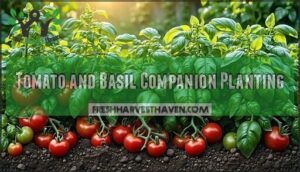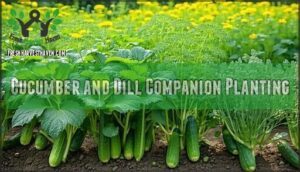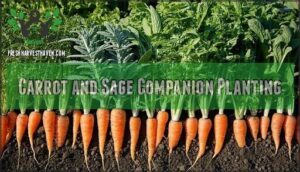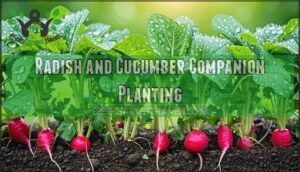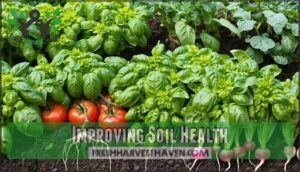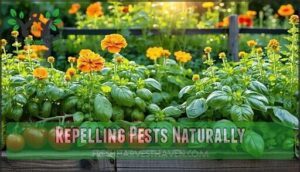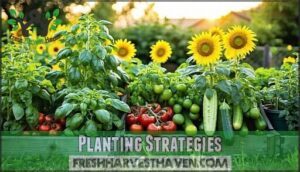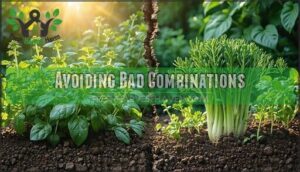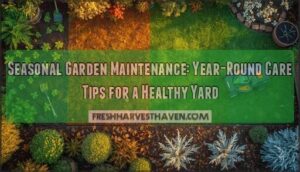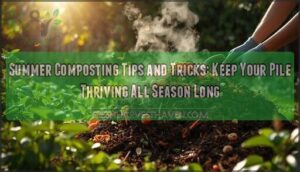This site is supported by our readers. We may earn a commission, at no cost to you, if you purchase through links.
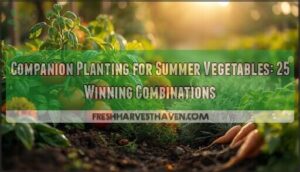
You’ll pair tomatoes with basil to repel pests, plant onions near peppers for disease protection, and grow cucumbers alongside dill for improved flavor.
These strategic combinations boost yields, enhance soil health, and reduce the need for chemicals.
Carrots thrive next to sage, while radishes help cucumbers by deterring harmful insects.
The magic happens when you understand which plants share resources versus compete for them.
Master gardeners know that successful companion planting requires timing, spacing, and selecting the right varieties – secrets that can double your harvest.
Table Of Contents
- Key Takeaways
- Summer Vegetable Pairings
- Companion Planting Benefits
- Planting Strategies
- Avoiding Bad Combinations
- Advanced Companion Planting
- Frequently Asked Questions (FAQs)
- Which vegetables grow well together chart?
- What fall vegetables can be planted together?
- Can you plant any vegetables in August?
- Are there any vegetables you can plant in July?
- Should you plant companion vegetable plants in your garden?
- Should you plant vegetables together?
- Which vegetables grow best with a companion plant?
- What vegetables grow well together?
- What plants are good for a vegetable garden?
- Which vegetables support the growth of other plants?
- Conclusion
Key Takeaways
- You’ll maximize your garden’s potential by pairing compatible plants – tomatoes with basil, peppers with onions, and cucumbers with dill create natural partnerships that boost yields while deterring pests through strategic plant combinations.
- You’ll improve soil health naturally through diverse root systems – companion plants work together to fix nitrogen, break up compacted soil, and enhance nutrient cycling without relying on chemical fertilizers.
- You’ll reduce pest problems by 50-65% using aromatic herbs – strong-scented plants like basil, chives, and marigolds confuse pest navigation systems and attract beneficial insects that hunt garden villains.
- You’ll avoid common mistakes by understanding plant compatibility – steer clear of nightshade family pairings, ensure proper spacing, and research which combinations compete for resources versus those that support each other’s growth.
Summer Vegetable Pairings
You’ll discover that certain vegetable combinations work better together than separately, creating natural partnerships that boost growth and flavor.
These strategic pairings help your summer garden thrive by improving soil conditions, deterring pests, and maximizing your harvest space, which ultimately leads to a more successful and flavorful harvest.
Tomato and Basil Companion Planting
You’ll love this classic plant pairing that delivers incredible flavor synergy.
Basil repels aphids, whiteflies, and hornworms while tomatoes provide natural growth support.
Companion planting transforms your garden into a natural partnership where vegetables thrive together through shared benefits.
These companion plants share similar watering needs and create efficient space optimization in your garden.
The aromatic herbs enhance tomato flavor while providing essential pest control.
This summer vegetable combination maximizes your harvest through strategic companion planting techniques.
Pepper and Onion Companion Planting
Why pair peppers and onions together? This classic combination delivers multiple garden benefits through strategic plant pairing.
Peppers and onions create an ideal partnership for summer vegetables through these key advantages:
- Optimal Spacing – Onions’ compact growth fits perfectly between pepper plants
- Pest Deterrents – Onion’s sulfur compounds repel aphids and pepper maggots
- Nutrient Competition – Shallow onion roots don’t compete with deeper pepper roots
- Flavor Enhancement – Both plants improve each other’s taste when grown nearby
- Soil pH – Both thrive in similar slightly acidic conditions (6.0-6.8)
This companion planting strategy maximizes garden space while naturally protecting your vegetable combinations from common pests.
Cucumber and Dill Companion Planting
You’ll find cucumber and dill make garden companions that enhance each other naturally.
Dill’s aromatic oils provide pest deterrence against cucumber beetles while attracting beneficial insects to your vegetable garden.
Their watering needs align perfectly for organic gardening success, and practice companion spacing by planting dill between cucumber rows.
This growth synergy improves flavor enhancement in both summer vegetables, creating an ideal growing vegetables partnership with natural pest deterrence.
Carrot and Sage Companion Planting
Beyond their culinary marriage, carrots and sage create remarkable garden synergy through complementary growing patterns.
Sage’s aromatic compounds provide natural pest control while carrots loosen soil for sage’s root system. This pairing demonstrates how organic gardening principles enhance both flavor enhancement and soil benefits.
Natural partnerships create garden magic through strategic plant placement and mutual benefits.
Here’s how this duo transforms your vegetable garden:
- Pest Control Benefits – Sage repels carrot flies and other harmful insects that typically damage carrot crops
- Growth Synergy – Carrots break up compacted soil, improving drainage and air circulation for sage roots
- Watering Needs – Both plants thrive with similar moderate moisture levels, simplifying irrigation schedules
- Garden Tips – Plant sage at row ends to maximize protection while allowing easy carrot harvesting access
Radish and Cucumber Companion Planting
Radish and cucumber create garden synergy through complementary growing habits.
Quick-maturing radishes break up soil for cucumber roots while deterring cucumber beetles and other garden pests.
This pairing maximizes space efficiency since radishes harvest before cucumbers spread.
| Radish Benefits | Cucumber Benefits |
|---|---|
| Fast growth rate (30 days) | Soil loosening from radish roots |
| Natural pest control | Reduced competition timing |
| Space-efficient companion | Better root development |
| Attracts beneficial insects | Enhanced flavor impact |
Plant radishes between cucumber hills during garden planning.
Both share similar watering needs, making maintenance simple.
Radishes complete their cycle before cucumbers require full space, supporting effective crop rotation strategies.
Companion Planting Benefits
You’ll discover that companion planting transforms your summer garden by creating natural partnerships between vegetables and their plant allies.
These strategic combinations work behind the scenes to improve soil health, deter pests, attract beneficial insects, boost yields, and enhance the flavor of your harvest.
Improving Soil Health
Companion plants work together like underground partners to build healthier soil naturally.
Your vegetable combinations can boost soil microbes, improve nutrient cycling, and increase water retention through strategic plant partnerships.
- Nitrogen fixers: Legumes add organic matter while feeding soil microbes
- Deep-rooted plants: Carrots and radishes break compacted soil for better water retention
- Living mulches: Low-growing herbs prevent erosion control while enriching soil structure
Repelling Pests Naturally
Strong-scented herbs like basil create natural barriers that confuse pest navigation systems.
You’ll reduce whitefly visits by 50% when planting basil near tomatoes.
Marigolds release compounds that suppress nematodes, while chives deter carrot flies by 65%.
These natural pest repellent strategies offer effective organic pesticides without chemicals.
Trap crops like nasturtiums draw pests away, supporting sustainable gardening practices.
Attracting Beneficial Insects
Your companion plants work overtime as pest control partners while creating habitat for beneficial insects.
Insectary plants like dill and fennel attract ladybugs and parasitic wasps that hunt garden villains.
Mixed plantings with cosmos and marigolds boost natural predators by 60%, reducing pesticide needs.
These pollinator gardens support specialist bees essential for squash and cucumber success, and smart habitat creation means healthier soil and sustainable gardening victories.
Increasing Crop Yields
You’ll see dramatic yield improvements when plants work together like a well-coordinated team.
Optimizing sunlight through strategic plant heights maximizes photosynthesis.
Smart water management prevents resource competition while nutrient cycling guarantees balanced soil amendments.
Effective pollination strategies boost fruit set, and natural pest control protects crops without chemicals, creating a thriving garden ecosystem.
Companion planting can reduce pest problems substantially.
Enhancing Flavor and Nutrition
Strategic pairing creates nutrient synergy that amplifies flavor profiles naturally.
You’ll notice basil enhances tomato sweetness while boosting vitamin levels through improved mineral uptake.
This taste enhancement stems from healthy soil interactions where companion plants develop better team chemistry.
Smart garden design promotes player development in your vegetable lineup, delivering superior nutrition and flavors.
Planting Strategies
You’ll get the best results when you plan your companion planting strategy before you start digging. Smart placement and timing turn good intentions into thriving gardens that practically manage themselves.
Crop Rotation and Companion Planting
Rotation Benefits multiply when you combine crop rotation with companion planting tactics.
Your planting sequence becomes your team strategy for soil health.
Moving heavy feeders like tomatoes after nitrogen-fixing beans restores soil nutrients naturally.
This garden design prevents Disease Prevention by breaking pest cycles while improving Weed Control through diverse root structures that compete for space effectively, which is a key part of companion planting tactics.
Interplanting for Maximum Benefit
Maximize your garden’s potential through smart interplanting techniques.
Plant quick-growing radishes between slower carrots to optimize space while radishes break up soil for carrot growth.
Combine tall corn with sprawling beans and squash—the classic "Three Sisters" method demonstrates perfect resource sharing.
Time your plantings so lettuce matures before tomatoes need full sun.
Consider also exploring various interplanting products to enhance your efforts.
These tactics improve soil health and boost yields through strategic growth habits coordination.
Creating a Companion Planting Chart
Design your companion planting chart like team building for your healthy garden.
Start with a clear Chart Key showing Plant Symbols for each vegetable.
Use reliable Data Sources from gardening resources to guarantee accuracy.
Smart Layout Design places compatible plants together visually.
Consider Interactive Charts that let you adjust tactics based on your space.
A well-designed layout can improve your garden’s overall health.
Your chart becomes strategic gameplay, mapping team tactics that boost growth and deter pests naturally, which is the key to a healthy garden.
Choosing The Right Companion Plants
When choosing companion plants, you’ll want to match growth habits and space requirements carefully.
Consider sunlight needs and soil preferences to guarantee plant compatibility works in your favor.
A healthy garden thrives when vegetables share similar environmental conditions.
Think of it like matchmaking for your plants – pairing tomatoes with basil creates perfect harmony, while mismatched companions compete for resources.
Some plants, like borage, are great for improving crop growth.
Maintaining a Companion Garden
Once you’ve selected your companion plants, successful garden maintenance becomes the cornerstone of your harvest success.
Regular monitoring keeps your paired vegetables thriving together throughout the growing season.
Companion planting can help with natural pest deterrence.
- Watering Needs: Group plants with similar moisture requirements together
- Soil Amendments: Apply compost monthly to support nutrient-sharing partnerships
- Pest Control: Monitor for beneficial insects and remove harmful pests naturally
- Ongoing Observation: Document which combinations work best for future seasons
Avoiding Bad Combinations
While companion planting offers many benefits, you’ll need to avoid certain vegetable combinations that can harm each other’s growth.
Some plants compete for nutrients, release chemicals that stunt growth, or attract pests that damage nearby crops.
Vegetables to Avoid Planting Together
Some vegetable pairings spell disaster in your garden.
Nightshade family members like tomatoes and potatoes share diseases, creating resource competition and disease spread issues.
Growth inhibition occurs when beans meet onions through allelopathic effects.
Brassicas and peppers increase pest attraction, particularly aphids. These incompatible plants demonstrate how poor planning leads to reduced yields and increased problems.
Avoiding such pairings can help guarantee improved soil fertility through better planning and understanding of allelopathic effects and resource competition.
Common Mistakes in Companion Planting
Many gardeners stumble by ignoring plant spacing needs, leading to overcrowding that stunts growth.
Poor planning often results in wrong timing for plantings, while neglecting research about compatible varieties creates problems.
Like mismatched rewards in a poorly designed transfer market, these mistakes reduce your garden’s potential. Proper customization of your planting strategy prevents these common pitfalls.
Solving Companion Planting Problems
When your companion plants show signs of trouble, quick fixes can save your garden.
Address Pest Resistance failures by adding beneficial flowers. Combat Nutrient Competition with targeted fertilization. Fix Growth Inhibition by adjusting spacing immediately.
- Monitor daily for Disease Spread between companion pairs
- Relocate plants experiencing Space Constraints before root damage occurs
- Document problem combinations for future reference
Identifying Incompatible Plants
Growth inhibition, resource competition, and allelopathic effects reveal plants that shouldn’t share garden space.
Watch for stunted growth when root vegetables compete with heavy feeders like tomatoes.
Disease spread accelerates between related plants – avoid planting nightshades together.
Pest attraction multiplies when susceptible plants cluster.
Just like a sports community using a mobile gaming app to track performance, monitor your garden’s interactions.
Your mobile app can help identify these warning signs before problems escalate in your summer vegetable patch, using tools like a mobile gaming app to track performance and identify warning signs.
Minimizing Companion Planting Risks
Start with careful plant selection to prevent problems before they begin.
Understanding plant toxicity and allelopathic effects helps you avoid combinations that naturally inhibit growth.
Resource competition occurs when plants fight for nutrients, water, or space.
Monitor for disease spread patterns and pest attraction issues.
Keep detailed records of what works in your garden to minimize future risks.
Advanced Companion Planting
Once you’ve mastered basic companion planting, you’re ready to create complex garden ecosystems that work harder for you.
Advanced techniques focus on building climate resilience, improving soil biology, and designing polyculture systems that mimic natural plant communities, which can help improve soil biology.
Using Companion Planting for Climate Resilience
During extreme weather events, strategic plant pairings create natural shields against climate challenges.
Tall sunflowers provide heat mitigation for sensitive crops while deep-rooted plants prevent soil erosion.
Dense plantings support biodiversity and carbon sequestration, building resilient ecosystems.
This approach conserves water through shade and mulching effects, protecting your garden investment.
Consider how tomatoes benefit from basil to maximize yields.
Companion Planting for Soil Health
Your soil’s foundation determines your harvest’s success.
Strategic companion planting builds soil structure through diverse root systems that improve water retention and nutrient cycling.
Legumes like beans fix nitrogen while deep-rooted plants break compaction.
Cover crops between vegetable rows protect against erosion control and feed beneficial microbial life.
This organic gardening approach transforms your summer vegetables garden into a self-sustaining ecosystem.
Experimenting With New Companion Planting Combinations
Breaking the mold with novel pairings opens new doors for your summer vegetables.
Try unconventional combos like spinach with corn or fennel alongside tomatoes—these experiments often reveal unexpected synergies.
Scientific validation shows mixed plantings can boost yields substantially.
Test resource competition by observing which combinations thrive together in your community garden space, and discover how unconventional combos can enhance your gardening experience.
Incorporating Herbs and Flowers
Beyond enriching your vegetable garden, herbs and flowers create aromatic influence while providing herb benefits that extend your growing season.
These colorful companions establish traditions of teamwork between plants, building community spirit in your garden space.
Consider these powerful partnerships:
- Basil with tomatoes – Enhanced flavor and pest control through aromatic influence
- Marigolds throughout beds – Natural nematode deterrent with vibrant flower attractants
- Nasturtiums as ground cover – Edible flowers that trap aphids while adding color
- Lavender borders – Aromatic barriers that repel unwanted insects effectively
- Borage near strawberries – Improves fruit flavor while attracting beneficial pollinators
For ideal results, consider specialized plant pairings for these combinations.
Creating a Polyculture Garden
Polyculture gardens mimic nature’s biodiversity benefits by combining multiple crops in strategic arrangements.
You’ll create ecosystem stability through careful polyculture design that maximizes resource optimization while providing natural pest control.
This tactical approach requires tactical adjustments based on each plant’s needs, much like football tactics demand tactical depth and gameplay awareness for ecosystem stability and success, utilizing natural pest control.
Frequently Asked Questions (FAQs)
Which vegetables grow well together chart?
Traditional gardens clash dramatically with strategic companion planting, where certain vegetables thrive together while others compete for resources.
You’ll find tomatoes flourish alongside basil and peppers, while beans fix nitrogen for corn and squash partners.
Carrots grow well with onions, and lettuce complements most crops, making them ideal for a harmonious and strategic garden setup.
What fall vegetables can be planted together?
You’ll find great success pairing root vegetables like carrots with leafy greens such as kale, spinach, and lettuce.
Plant radishes alongside Brussels sprouts and broccoli for natural pest control and space efficiency.
Can you plant any vegetables in August?
Yes, you can plant several vegetables in August! Cool-season crops like lettuce, spinach, radishes, and kale thrive when started now for fall harvest.
Are there any vegetables you can plant in July?
Summer’s planting window stays wide open in July! You can still sow quick-growing crops like beans, lettuce, radishes, and summer squash for fall harvests.
Should you plant companion vegetable plants in your garden?
Companion planting works like a natural partnership system – you’ll boost yields, deter pests, and improve soil health by strategically pairing vegetables that support each other’s growth and protection needs.
Should you plant vegetables together?
Studies show companion planting can increase yields by 20-30%.
You should plant compatible vegetables together because they share nutrients efficiently, deter pests naturally, and maximize garden space while improving soil health through diverse root systems.
Which vegetables grow best with a companion plant?
Looking for vegetables that thrive with companions? You’ll find tomatoes excel with basil, carrots love onions, and beans boost corn’s growth.
These partnerships improve flavor, deter pests, and maximize your garden’s potential through natural synergy.
What vegetables grow well together?
Like threads weaving through nature’s tapestry, certain vegetables create partnerships that strengthen each other’s growth.
You’ll find tomatoes thrive alongside basil, while carrots and onions form natural alliances that repel pests and maximize your garden space efficiently, creating a natural balance.
What plants are good for a vegetable garden?
You’ll get fantastic results growing tomatoes, peppers, cucumbers, lettuce, beans, carrots, zucchini, herbs like basil and parsley, plus radishes and spinach in your garden.
Which vegetables support the growth of other plants?
Certain vegetables act like green guardians in your garden, creating beneficial partnerships.
You’ll find legumes like beans and peas fix nitrogen, enriching soil for heavy feeders like tomatoes and corn nearby.
Conclusion
Success doesn’t happen overnight when you’re building your dream garden through companion planting for summer vegetables.
You’ve learned twenty-five proven combinations that’ll transform scattered plots into thriving ecosystems.
These strategic partnerships boost yields while reducing pest problems naturally.
Your tomatoes will flourish beside basil, cucumbers thrive with dill, and peppers benefit from onion neighbors.
Start small with three combinations this season, then expand as you gain confidence and experience, using proven combinations to guide you.

